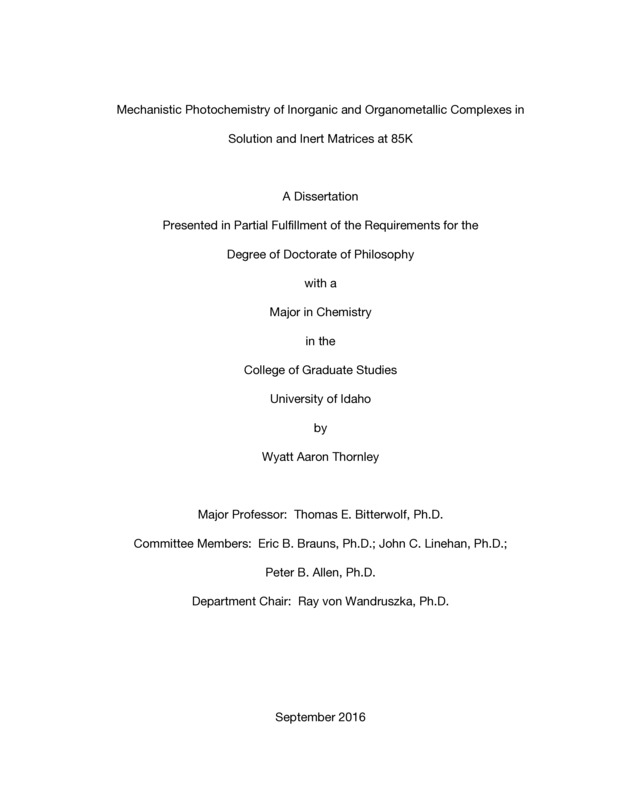Mechanistic Photochemistry of Inorganic and Organometallic Complexes in Solution and Inert Matrices at 85K
Thornley, Wyatt Aaron. (2016). Mechanistic Photochemistry of Inorganic and Organometallic Complexes in Solution and Inert Matrices at 85K. Theses and Dissertations Collection, University of Idaho Library Digital Collections. https://www.lib.uidaho.edu/digital/etd/items/thornley_idaho_0089e_10654.html
- Title:
- Mechanistic Photochemistry of Inorganic and Organometallic Complexes in Solution and Inert Matrices at 85K
- Author:
- Thornley, Wyatt Aaron
- Date:
- 2016
- Keywords:
- Hydrogenase Matrix Isolation Nitric Oxide Oxidative Addition Photochemistry Reductive Elimination
- Program:
- Chemistry
- Subject Category:
- Chemistry
- Abstract:
-
Matrix-isolation FTIR at cryogenic temperatures and traditional solution experiments have been used to study the mechanisms of new and previously reported photochemical reactions of inorganic and organometallic complexes. Spurred by lack of consensus for the mechanism of the photodecomposition of permanganate, one of the earliest reported inorganic photoreactions, a broad survey upon the photochemistry of inorganic and organometallic oxides and nitrides was conducted. These studies yielded the only known example of reversible six-electron reductive elimination and oxidative addition, coming in the form of a nitrosyl ligand from the nitridoosmate anion, the identity of the key intermediate and mechanism of the photodecomposition of permanganate, and a new competitive photopathway in the photochemistry of the O2 adduct of Vaska’s complex, an archetypal organometallic photoreaction.
As a means to study the structure and bonding of the [FeFe]-hydrogenase enzyme active, a potential model for a future hydrogen energy economy, the photochemistry of structural models of this active site has been studied. At cryogenic temperatures, photoejection of CO is observed resulting in a product that may then undergo secondary photolysis to form either a bridging carbonyl ligand as found in the natural enzyme, or result in C-H bond activation of the alkyl dithiolate bridge which may serve as a new model for proton or hydride transfer in the catalytic cycle of the [FeFe]-hydrogenase enzyme. Photodecarbonylation of dithiolene derivatives of [FeFe]-hydrogenase model complexes results in the formation of uncommon aromatic metallacycles.
Photolysis of a series of allyl complexes in the TpM(CO)2(η3-C3H4R), where Tp=tris(pyrazolyl)borate, M=Mo or W, and R=2-H or 2-Me, family of compounds was found to result in in exo/gauche rotameric isomerism of the allyl ligand, exhibiting behaviour distinct from the closely related CpM(CO)2(η3-C3H4R) (Cp = η5-cyclopentadienyl) complexes that undergo endo/exo rotameric isomerism.
Finally, a series of organometallic diazonium complexes were studied at cryogenic temperatures. Diazonium ligands are isoelectronic with the well-studied nitrosyl ligand, and these initial studies reveal, that like their nitrosyl counterparts, diazonium ligands undergo η1 to η2 linkage isomerism following photoexcitation. An additional photoreaction, whereby homolysis of the diazonium ligand occurs to yield two radical species is also reported.
- Description:
- doctoral, Ph.D., Chemistry -- University of Idaho - College of Graduate Studies, 2016
- Major Professor:
- Bitterwolf, Thomas E
- Committee:
- Linehan, John C; Brauns, Eric B; Allen, Peter B
- Defense Date:
- 2016
- Identifier:
- Thornley_idaho_0089E_10654
- Type:
- Text
- Format Original:
- Format:
- application/pdf
- Rights:
- In Copyright - Educational Use Permitted. For more information, please contact University of Idaho Library Special Collections and Archives Department at libspec@uidaho.edu.
- Standardized Rights:
- http://rightsstatements.org/vocab/InC-EDU/1.0/

